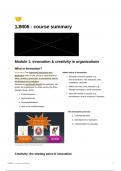1JM06 - course summary
Module 1: innovation & creativity in organizations
What is innovation?
Innovation: the intentional introduction and Added value of innovation:
application within a role, group or organization of
Stimulate economic growth; e.g.,
ideas, products, processes, or procedures, new to
new procedures, new industries, new
the relevant unit of adoption,
companies, new jobs
designed to significantly benefit the individual, the
group, the organization or wider society (De Dreu, Makes our lives more pleasant; e.g.,
Nijstad & Baas, 2010). lifestyle innovations, work innovations
Product/process Deal with threats to society; e.g.,
environment, scarce resources, diseases
Technical/social
Incremental/radical
New to the world/company
The innovation process:
1. Conceptualization
2. Development & realization
3. Customization & evaluation
Visualization of the innovation process.
Creativity: the starting point of innovation
1JM06 - course summary 1
, Creativity: the ability to come up with Indicators of creative performance:
ideas, problem solutions, or insights that are both
1. Fluency: the number of non‐
novel and appropriate within a given domain (e.g.,
redundant ideas
Amabile, 1996).
2. Originality: uncommonness
Appropriate but not novel: routine, non‐
exceptional 3. Flexibility: the number of content/cognitive
categories
Novel but inappropriate: useless, non‐
functional
Three theoretical approaches to creativity:
→ Stimulating innovation & creativity in the workplace requires attention to conditions influencing
employees’ cognitive thinking skills, motivation, and affective tone and level of activation.
Cognitive Approach
Brain gymnastics: using different categories of knowledge to generate ideas and combine seemingly
unrelated ideas
Creative cognition (Flinke et al., 1992).
Motivational Approach (Amabile, 1998)
→ Six categories of managerial practices affect creativity.
Componential theory of creativity (Amabile, 1998).
1JM06 - course summary 2
, Challenge:
Stimulate creativity: Kill creativity:
Matching people with the right Not trying to obtain the information
assignments necessary to make good connections
between people and jobs
Not too little that employees feel bored, but
not so much that they feel overwhelmed
(threatened by a loss of control)
Freedom:
Stimulate creativity: Kill creativity:
People are more creative if they are given Change goals frequently or fail to define
freedom to decide how to climb a particular them clearly
mountain
Granting autonomy in name only; the
Autonomy around the process process is actually predefined, while
heightens intrinsic motivation & the claiming it is not
sense of ownership, fostering creativity
Don’t let them choose which mountain to
climb → clearly specified strategic goals
enhance creativity
It is difficult to work creatively towards
a moving target
Resources:
“Money doesn't necessarily stop people from being creative, but in many
situations, it doesn't help.”
Stimulate creativity: Kill creativity:
Time pressure can (in some situations) Fake deadlines → distrust
heighten creativity → increase creativity by
Impossible or tight deadlines → burnout
increasing the time-related challenge
No allowance for exploration time, or an
Resources above a threshold of sufficiency
incubation period
does not boost creativity
Keep resources tight, pushing people to
Resources below a threshold of sufficiency
use their creativity to find additional
dampens creativity
resources
Overemphasis of creating the “right”
physical space for creativity
Work-group features:
Stimulate creativity: Kill creativity:
1JM06 - course summary 3
, Mutually supportive groups with a diversity Homogeneous teams → reach solutions
of perspectives & backgrounds: more quickly & with less friction, reporting
high morale
1. Share excitement over the goal
Although no efforts towards creative
2. Willingness to help others
thinking
3. Recognize every person’s unique
contributions
Supervisory encouragement:
Stimulate creativity: Kill creativity:
Generously recognize creative work before Specific extrinsic rewards for certain
even the impacts/results are known outcomes
Serve as role models, and encourage Habit of critically reacting to new ideas →
collaboration & communication often even professionally rewarding
Culture of evaluation leads to:
Focus on extrinsic rewards
Climate of fear → undermining intrinsic
motivation
Organizational support:
Stimulate creativity: Kill creativity:
Reward creativity Reward with money to “bribe” people to
come up with creative ideas
Information sharing & collaboration support
all three components of creativity Political problems → work is threatened by
others’ agendas
Obstructs open communication &
information flows
Affective Approach (De Dreu et al. 2010)
Moderate levels of activation lead to:
Task engagement & motivation
Improved cognitive functions:
1. Cognitive flexibility → due to positive
activating moods (e.g., feeling happy &
elated) The dual pathway to creativity by De Dreu et al.
(2010).
2. Cognitive persistence → due to negative
activating moods (e.g., feeling angry)
→ Other factors such as the fit between task
demand & personality promote both
Increase flexibility (in case of broad topics): Increase persistance (in case of narrowly-
1JM06 - course summary 4





